Use of Asbestos and the risk of Mesothelioma
What is Asbestos?
Asbestos is a natural silicate mineral with long, thin fibrous crystals. Because of its resistance to heat, electrical and chemical damage, sound absorption and tensile strength, asbestos became highly popular among manufacturers and builders in the late 19th century. When it is used as a fire or heat resistant material, the fibers are often mixed with cement or woven into fabric or mats. Asbestos was used on electric oven and hotplate wiring for its electrical insulation at elevated temperature, and in buildings for its flame-retardant and insulating properties, tensile strength, flexibility, and resistance to chemicals.
The name Asbestos has been given by the ancient Greeks. Wealthy Persians amazed guests by cleaning the cloths made of asbestos fibre by simply exposing it to fire. Some of the Persians believed the fiber was fur from an animal that lived in fire and died when exposed to water.
Marco Polo has described about some miraculous garments when he travelled to China, which had been cleaned by placing them in fires. These garments were likely made from asbestos.
Asbestos became popular during the industrial revolution in the 1860s. Development of the first commercial asbestos mine began in 1879 in North America. By the mid 20th century, asbestos was being used for fire retardant coatings, concrete, bricks, pipes and fireplace cement, heat, fire, and acid resistant gaskets, pipe insulation, ceiling insulation, fireproof drywall, flooring, roofing, lawn furniture, and drywall joint compound.


Asbestos is considered as a toxic material. The inhalation of asbestos fibers can cause serious illnesses including malignant lung cancer and Mesothelioma. In the mid 1980s, the European Union and most developed countries have banned asbestos.
Approximately 100,000 people have died in the United States from asbestos exposure related to ship building. Thousands of tons of asbestos were used in ships during the World War II to wrap pipes, line the boilers, and cover engine and turbine parts. For every thousand workers about fourteen have died of mesothelioma and an unknown number of people have died from other diseases related to asbestos.
In the European Union and Australia asbestos is banned as a potential health hazard and is not used at all.
Asbestos exposure becomes a health concern when high concentrations of asbestos fibers are inhaled over a longer period of time. People who become ill from inhaling asbestos are often those who are exposed on a day-to-day basis directly with the material. Disease is very unlikely to result from a single high-level exposure or from a short period of exposure to lower levels. Smoking combined with asbestos exposure may increase the health risk dramatically.
What is Mesothelioma?
It is a type of cancer caused by exposure to asbestos. In this disease, malignant cells develop in the mesothelium which is a protective lining that covers most of internal organs in our body. It occurs mostly in the outer lining of the lungs and internal chest wall which is called pleura. It may also occur in the areas such as the lining of the abdominal cavity called peritoneum and also in the heart and in the double-walled sac that surrounds the heart called pericardium and tunica vaginalis which is the serous covering of the testis.


The diagnosis of mesothelioma isdone with chest X-ray and CT scan. It can be confirmed with a biopsy and microscopic examination. A procedure of inserting a tube with a camera into the chest called thoracoscopy can be used to take biopsies.
Most of the people who develop mesothelioma are those who have worked in environments where asbestos particles are inhaled during the job or those who have been exposed to asbestos dust and fiber in other ways. For example a person washing the clothes of a family member who worked with asbestos can be at risk for developing mesothelioma.
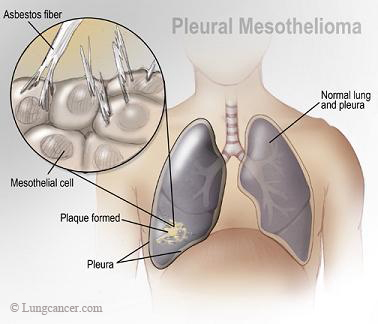
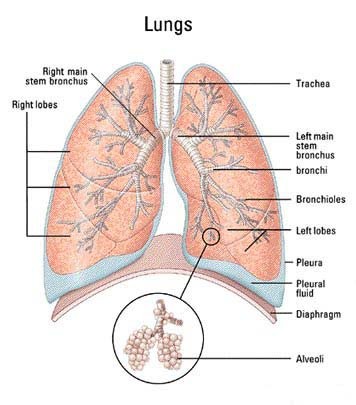
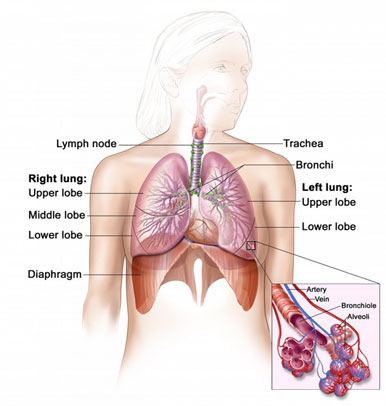

Symptoms of mesothelioma appear 20 to 50 years after exposure to asbestos. Shortness of breath, cough, and pain in the chest due to an accumulation of fluid in the pleural space are often symptoms of pleural mesothelioma.
Symptoms of peritoneal mesothelioma include weight loss, abdominal swelling and pain due to buildup of fluid in the abdominal cavity. Other symptoms of Peritoneal Mesothelioma may include bowel obstruction, blood clotting abnormalities, anemia, and fever. If the cancer has spread beyond the mesothelium to other parts of the body, symptoms may include pain, trouble swallowing, or swelling of the neck or face.
These symptoms may be caused by mesothelioma or by other, less serious conditions.
Mesothelioma that affects the pleura can cause undermentioned signs and symptoms:
- Chest wall pain
- Pleural effusion, or fluid surrounding the lung
- Shortness of breath
- Fatigue or anemia
- Wheezing, hoarseness, or cough
- Blood in the fluid coughed up
Diagnosis of mesothelioma is often difficult because the symptoms are similar to those of a number of other conditions. Diagnosis begins with a review of the patient's medical history. A history of exposure to asbestos may increase clinical suspicion for mesothelioma. A physical examination is performed, followed by chest X-ray and often lung function tests. The X-ray may reveal pleural thickening commonly seen after asbestos exposure and increases suspicion of mesothelioma.
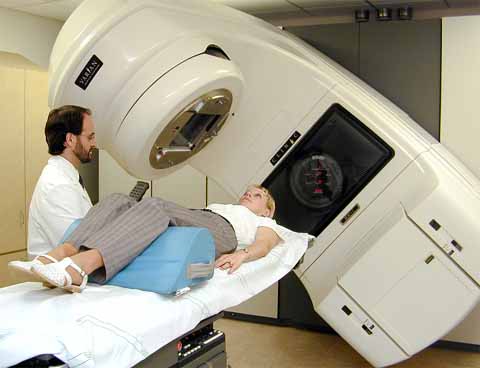
- Objectives
of Public and Private organizations A comparison
Both public sector and private sector organizations have objectives and missions. But depending on the type of organization, there are differences between the public and private sectors of a country. - Regulatory
Authorities Objectives and main activities
Regulatory bodies are established in countries according to the policy of the government with different types of authorities. Regulatory rules are designed to meet government objectives. - Concerns
of the business manager in protecting environment
Protecting the environment is considered nowadays as a key issue affecting everyone. Business organizations are pressurized to ensure that the environment suffers minimum damage due to their processes, products and services. - Effects
of high inflation
Inflation means rising prices and it shows the increase in cost of living. In economics, inflation is explained as rise in the general level of prices of goods and services in an economy over a period of time. - Interest
Rate A major economic force affecting financial plans
Rate of interest is the price of money which is lent or borrowed. It is always expressed as a percentage of the sum lent or borrowed. It is generally calculated on an annual basis. - A
profit for not-for-profit organizations
Not-for-profit entities do not expect profits. They are established not for profits but to achieve different objectives of the society. But, can these organizations operate without identifying and satisfying the needs? - What
is a Search Engine and how does it work
A Search Engine is a web site designed to search for information on the World Wide Web. What happens when someone enters a query into a search engine? The Search Engine then examines its index and displays a list of best-matching web pages.








